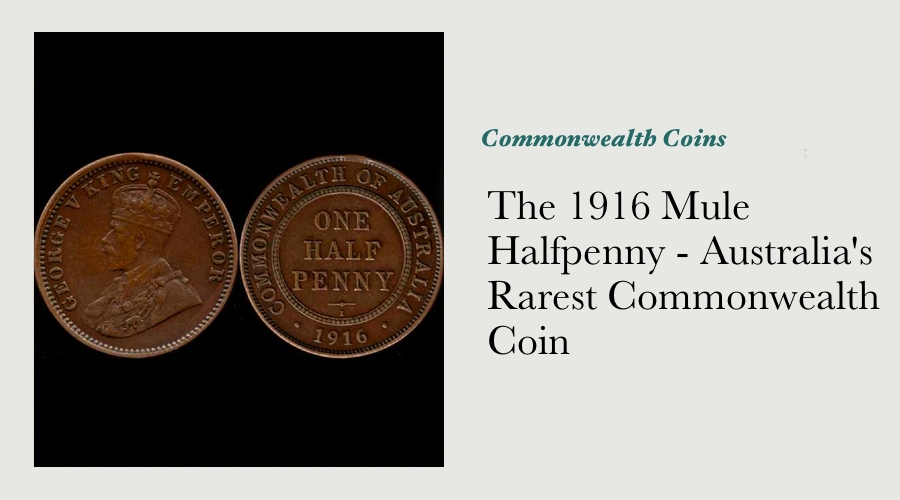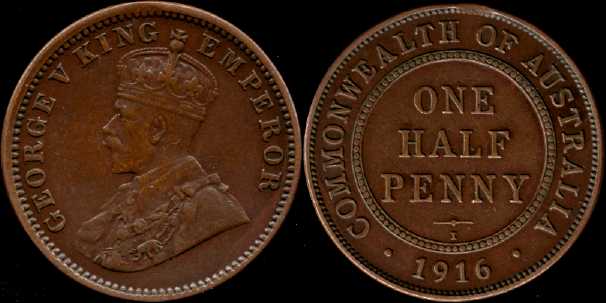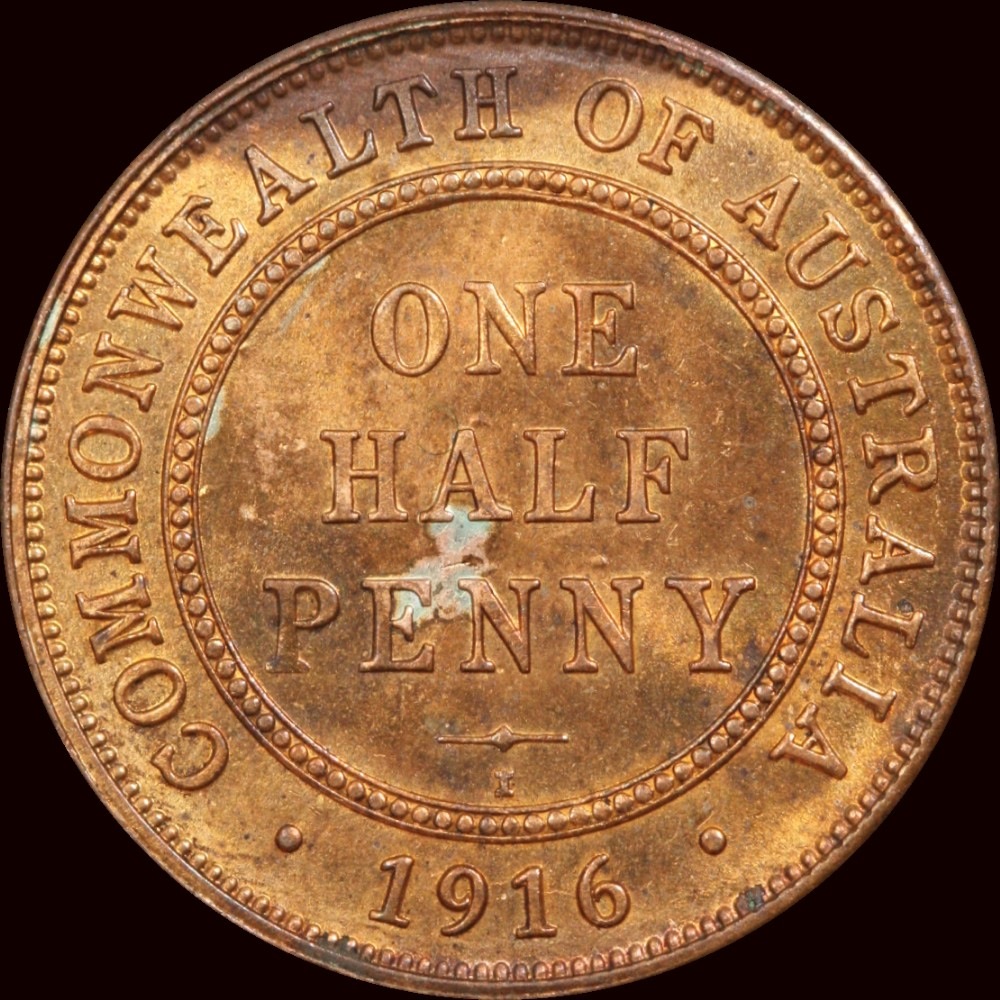The 1916 Mule Halfpenny - Australia's Rarest Commonwealth Coin

The 1916 mule halfpenny is the rarest Commonwealth coin issued for circulation in Australia, and is certainly among the rarest of all Australian coins.
When it first began to gain publicity in the numismatic press in the middle of 1965, it was described as “the biggest find in coin history, and one of the most valuable”. That this overwhelming international recognition came at the time when collectors were first becoming aware of the coin's existence and importance has set an atmosphere of intrigue, wonder and awe each time an example of this truly rare coin has become available to the collectors market.

Like any numismatic item, the 1916 Mule halfpenny appeals to different collectors for different reasons – some are compelled to own it for its unmatched rarity, others wish to delight in the incongruous nature of the mismatched designs, others wish to become one of the very few collectors that own a truly complete Australian Commonwealth set, while still others are keen to own a tangible slice of one of the most polarizing stores in Australian numismatics.
There are so many angles to the history of this coin that many collectors take quite some time before they fully appreciate the position this coin has in Australian numismatics. Not only is there a whole story just in discovering how the coin came to exist, but there are the allegations of forgeries at the time the coins were discovered, coins being sent off to various points of the globe for authentication, as well as further allegations of Mint staff producing coins 40 odd years after their original issue date – under the authority and supervision of their Deputy Master!
That there could be even a hint of controversy over any item officially struck at a branch of the Royal Mint is news to many collectors, however it is fair to state that the 1916 Mule halfpenny is a coin that has ignited spirited debate ever since it was first publicised in 1965. The lack of a “Webster's Numismatic Dictionary” or equivalent leaves us with several different definitions of what a “mule” is in numismatic terminology.
The animal the mule is regarded as being a hybrid offspring of a (female) horse and a (male) donkey, one that has an equal number of characteristics from both parents. The numismatic definition of a mule that I prefer is “a coin that has been struck with obverse and reverse dies that were not originally intended to be used together”.
Enigmatic Australian Error Coin Came About Following The Outbreak Of WWI
The 1916 Mule halfpenny was struck with the reverse die of an Australian 1916 halfpenny, and the obverse of a (British) Indian Quarter Anna. This enigmatic Australian error coin came about following the outbreak of WWI , once the Royal Mint in London delegated the production of a range of Australian copper and silver coins to the Calcutta Mint. This switch of location was brought about to allay concerns that the German Navy may have had the capability of sinking or intercepting maritime deliveries of coinage from Britain to Australia, the consequences of which would not only have been expensive but morale-shattering as well.

This outsourcing was certainly not without precedent, as it had been relatively common practice for the Royal Mint or British Treasury to delegate less important components of its production responsibilities to other mints such as the Soho or Heaton Mints at Birmingham. The “Cartwheel” penny of 1797 is just one such coin that most Australian collectors will be familiar with.
Australian 1916 Penny And Halfpenny Were However The First Non-Indian Coins To Be Produced By The Calcutta Branch Of The Royal Mint
The Australian 1916 penny and halfpenny were however the first non-Indian coins to be produced by the Calcutta branch of the Royal Mint. The Royal Mint banches in India (Calcutta and Bombay) had been successfully producing silver rupees and copper annas since 1862, so certainly had the resources, systems and experience to handle the task.
The very existence of the 1916 Mule halfpenny indicates however that the internal controls at the Calcutta Mint were not without fault however – clearly at least one Indian obverse die was somehow mixed in with the Australian obverse dies intended to produce the 1916 half pennies required.
Just how this error came about however remains open to debate. The diameter, weight, thickness and composition of the halfpenny and Quarter Anna are all remarkably similar, so Calcutta Mint staff could perhaps be forgiven for the one-off mistake of accidentally mixing in one similar-looking die with a number of others. One would presume however that there would be extremely strict controls over the movement of dies within the Mint's premises, which could indicate that the use of the Indian obverse ? Anna die was intentional, perhaps to cover a very minor short fall in die capacity. One would think that such a shortfall would have been somewhat greater than the remaining population of mule halfpennies indicates, confirming that more research into this coin is required.
The true explanation will only ever come to light if Calcutta Mint staff of that era happened to record the facts surrounding the production of the coins, and further if those records have been retained in Royal Mint archives, and even further if these records remain accessible to researchers today. Sadly for Australian numismatists, none of these latter three points can be relied upon – records at any of the branch mints are notorious for lacking even the most basic details about production, many records have since been destroyed and those that do remain are often largely inaccessible to numismatic researchers.
Bill Myatt & Tom Hanley state that “about 250 of these coins are supposed to have been struck at the Calcutta Mint, where all of the Australian bronze of 1916-1918 was produced, some 60 being given away and the rest added to the general Australian issue. It is nothing short of amazing this mule was not noticed before 1965 when one turned up in Adelaide.”
All Known Examples Of The 1916 Mule Halfpenny Discovered Have Been Located In Australia
The fact that all the known examples of the 1916 Mule half penny discovered to date have been located in Australia, could lead some to presume that if the mules were caused solely by the deployment of an incorrect die or dies, the planchets of all known mules would correspond approximately with that of an Australian halfpenny of the King George V period, 5.67g.
I am not familiar with the acceptable tolerance for a circulated Australian halfpenny dated between 1911 and 1936, however a preliminary appraisal of the weights of the mules known to exist (between 5.11g and 5.90g), indicates that a more complex story will explain the origin of at least some of these enigmatic coins.
The very first discovery of a 1916 Mule halfpenny was allegedly made in Grovene (South Australia) by a Mr Robert Koschade between 1930 and 1933 – the average collector would expect that the date of this discovery (if a genuine fact) would clearly indicate that this coin at least is a genuine mule. The veracity of this claim however could technically be disputed, as it was not actually “discovered” within Mr Koschade's estate until July 21st, 1965.
The first public knowledge of the 1916 Mule was on July 8th 1965, when Mr Cecil Poole presented the example he found to the July meeting of the Numismatic Society of South Australia. This coin was discovered by Mr Poole while sorting through bulk halfpennies – it was the subject of an article written by Dion Skinner, and published in the Australian Numismatic Journal between July and September 1965. The story of Poole's find was published in the mainstream print media on July 14th.
On July 25th 1965, Mr C.H. Graus of Fitzroy (Victoria) “reported” his discovery, making his the 3rd example to be made public.
The Koschade example was sold by Ian Mudde by public auction in Stow Hall (SA) on July 27th, and was bought by Dion Skinner for ?80.
The first of a series of articles on the 1916 Mule was published in the Australian Coin Review (ACR) in November 1965, this one written by the South Australian numismatist, Dion Skinner.
The Victorian numismatic dealer PJ Downie sold two examples in mid December – the first to the Museum of Applied Arts & Sciences in Sydney (now the Powerhouse Museum) for £240; the second to a private collector, also in Sydney, for £175.
A War Of Letters Over The Authenticity Of The 1916 Mule Erupted In The Coin Review Magazine
A war of letters over the authenticity of the 1916 Mule erupted in the Coin Review Magazine between June 1966 and March 1967, one that involved a number of the leading dealers and collectors of the day, the Controller of the Royal Australian Mint in Canberra, and expert staff at the Royal Mint in London. Comprehensive diagnostic tests were conducted by staff at the Royal Mint in London and the RAM in Canberra, these tests included x-rays and metallurgical testing. Despite some protests over the accuracy of these tests, the controversy was largely put to rest by the ACR Editor in March 1967.
This course of events shows that 5 examples were discovered between July and December 1965 – I have sighted at least 1 other genuine example not listed here, and have been informed by other dealers that there may be at least 2 1916 Mules held by private collectors. With these figures, it quite easily remains Australia's rarest Commonwealth coin issued for circulation – no other circulating coin comes even close to it in terms of population rarity.
What does the future hold for the 1916 Mule halfpenny? One of the more considered forecasts in world numismatics is that the market for rare Indian coins will expand exponentially in the coming years. The ongoing increase in the Indian population, along with the marked rise in the size of India's middle class, is thought will feed an unprecedented number of new collectors of all types of Indian coins. If just a dozen or so wealthy Indian collectors decided that the “Australian” 1916 Mule was integral to their own collection, values for these highly prized rarities could escalate even further.
The market for error and variety coins in the United States alone is so large that there are numerous dealers that trade error coins and notes not as a sideline, but as their sole area of specialisation. Just one valuable US coin error that I'm aware of is a 1999 Lincoln Cent planchet that has an obverse die muled with a Roosevelt dime reverse. This coin is apparently one of just 7 such mules that had been sighted prior to 2003 (a number of other double-denomination mules have been discovered since then), and made US$138,000 when it was offered at auction in April 2006. Demand for other Australian numismatic icons such as the Holey Dollar and the Type I Adelaide Pound has been strong in recent years, it isn't too large a leap of faith to consider that the same demand could be seen for an incredibly rare mule that spans two nations, let alone two denominations.
There is little doubt in my mind that as further research is done in fleshing out the recent history of this coin, and collectors become more confident in trading them, the 1916 Mule Halfpenny will continue to set an atmosphere of intrigue, wonder and awe each time an example becomes available to the collector market.